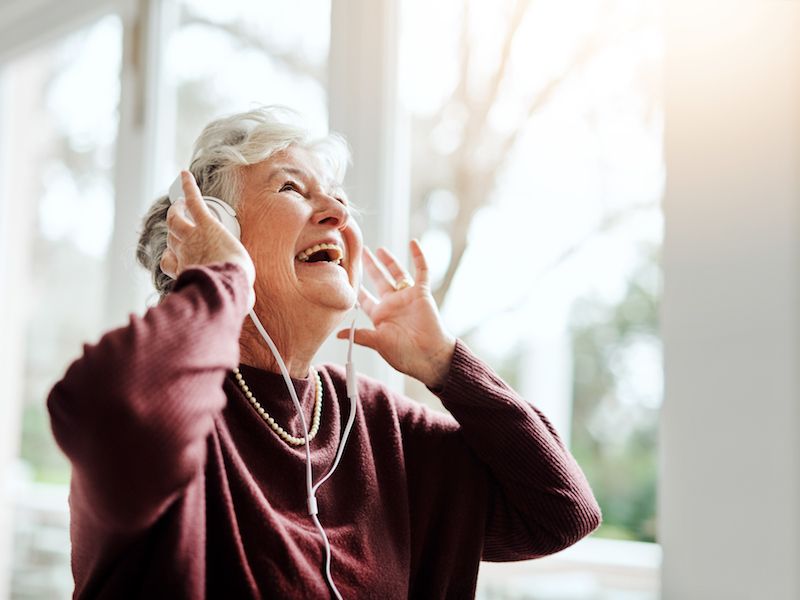
Noise-related loss of hearing doesn’t just affect people who work in loud surroundings, such as construction workers or heavy metal roadies. Leisure related noise exposure can be just as damaging as work related noise exposure. The most common type? Loud sounds heard through headphones, whether it be music, gaming, streaming video, or even an audiobook with the volume turned up.
You may be alarmed to learn that a mobile device can get that loud. The average pain threshold for human hearing is about 150 db which is in the range of these devices. Your ears will literally start to hurt at this volume. So what can you do to safeguard against this kind of noise-related loss of hearing?
It’s relevant here to consider the volume. A quick shorthand that’s widely recommended is the 60/60 rule: Listen with the volume at or below 60% for 60 minutes or less at a stretch (because the length of sound exposure matters, too).
Your Hearing Aids Can be Set up For Music
If you use hearing aids, you’re most likely streaming your device directly to your hearing aids, so be certain the volume is not too loud or that you’re not trying to drown out other noises with your music. And there are much healthier ways to listen to music so ask us about that also. Hearing aids aren’t designed to increase the quality of music like they do with voices so if really like music, you might have observed this. While enjoying music, we can most likely make various modifications to help enhance the quality of sound and reduce the feedback.
How to Choose The Right Headphones
When getting headphones there are numerous choices, especially if you wear hearing aids. It might be a matter of personal preference, but there are some things you should consider there too.
Over-the-Ear Headphones
Over the ear headphones are becoming popular again but you probably won’t see the old foam covered speakers that once came with a walkman. They have lots of options in style and color, are frequently endorsed by celebrities, and can be unexpectedly pricey. And unlike those little foam pads, these go over the entire ear, blocking outside sounds.
Main-stream perception is that these are less dangerous than in-ear headphones because the source of the sound is further from your eardrum. But because the speakers are larger they are normally capable of much higher sound level. Noise cancellation can be a helpful thing as long as you’re not losing needed sounds like an oncoming car. But on the positive side, you won’t have to compete with outside sound so you can enjoy your music at lower volumes.
Earbuds
The standard earbuds that come with devices such as iPhones are known for their poor sound quality, though lots of people still use them because hey, they came with the phone. Moreover, with newer versions that don’t have a headphone jack, staying with Apple’s earbuds can simply be easier.
The drawback, aside from the poor sound quality, is that basic earbuds don’t cancel outside noises, so that it’s more likely that you will pump up the sound level. It’s commonly assumed that inserting earbuds so close to your eardrum is the main problem but it’s actually the volume.
Noise Blocking Earbuds
Lots of people prefer earbuds with a rounded, rubbery tip both because they’re more comfortable than standard earbuds and better at blocking outside noises. The rubber molds to the shape of your ear, creating a seal that stops other noises from entering. Not to sound like a broken record, but these types of earbuds have the same downsides as the other two (volume is the main problem), as well as carrying the same caution as over-the-ear headphones (they can block out warning sounds). And if you use hearing aids, clearly these won’t work for you.
A number of pairs will probably need to be evaluated before you find headphones that work for you. Depending on what you regularly use them for say talking on the phone, versus listening to music, you’ll have different acoustic expectations. The essential thing is to find headphones that make it comfortable for you to enjoy at a safe sound level.
Don’t Cut Corners When it Comes to Your Hearing
Is it Safe, How Can I be Sure? If you own a smartphone, you can get an app for that, you can get the National Institute for Occupational Safety and Health’s free Sound Level Meter app. You can get different apps, but studies has discovered that the reliability of these other apps is hit-and-miss (additionally, for reasons yet unknown, Android-based apps have been shown less precise). That prompted NIOSH to create an app of their own. The app lets you measure outside noises, but sounds coming out of your device’s speakers can also be measured, so you will learn precisely how much volume your ears are subjected to. You have to put in a little effort, but taking these types of protective steps can help protect your hearing.
The content of this blog is the intellectual property of MedPB.com and is reprinted here with permission.
The site information is for educational and informational purposes only and does not constitute medical advice. To receive a personalized free hearing test and hearing loss consultation, call today to set up an appointment.









